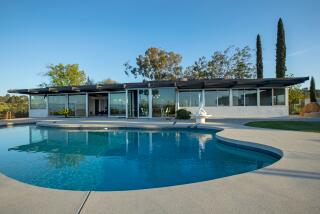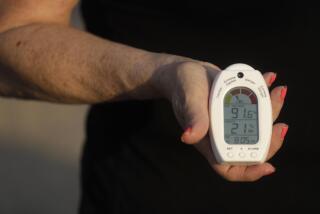Spa business is no place to relax
Amid the squeal of machinery and the hiss of plastic being molded, the Pomona factory owned by LMS Inc. turns out a signature California creation: the hot tub.
But the squealing and hissing have slowed in recent years, so much so that company President Casey Loyd says the operation these days is less like an assembly line and more like a hospital where “all kinds of babies are coming out at all different times,” each a custom job.
“We don’t build orphans here,” Loyd said. “Every one of these spas has already got a home.”
That’s one way that LMS, which produces Cal Spas and other well-known lines, has survived an industrywide slump that began well before the recession.
Sales peaked at 417,000 units in 2004, according to the Assn. of Pool & Spa Professionals. In 2010, the industry saw a modest increase of 7,000 units from the year before, but those 182,000 sales came too late to prevent dozens of spa manufacturers from going out of business. The trade group is still gathering 2011 sales data, but officials are hoping for at least a slight improvement from 2010.
During the worst of the decline, Loyd and his family, which own LMS, decided to expand rather than retrench.
They began manufacturing pretty much everything needed to transform a backyard into a resort, including outdoor ovens, grills, fire pits, fireplaces, outdoor rooms and gazebos.
In 2010, the company’s hottest product was for the first time not a spa; instead, the bestseller was a granite-topped, four-burner grill with a refrigerator and storage space. Spas reclaimed the No. 1 spot last year in the form of the Ultimate Fitness F1640 Swim Spa, which has 40 jets, allows the user to swim in place and is priced at $22,999.
LMS also expanded its spa offerings, signing a deal in 2009 to make spas under the Coleman Co. brand name. Last year, it added the American Spas and Geo Spas lineups, hoping to appeal to new buyers.
“American Spas is a line of feature-rich hot tubs for every lifestyle with budget-friendly price points,” Loyd said. “Geo Spas is a value-conscious line of eco-friendly hot tubs.”
The LMS manufacturing lineup now includes Cal Spas, Cal Flame, Cal Heat, Cal Designs, Cal Patio, OC Hot Tubs, American Spas, Geo Spas and Coleman Spas, all made in the company’s 500,000-square-foot factory.
Prices range from $600 for a fire pit to $35,000 for the Cal Flame GPV3100 Outdoor Kitchen with Sports Package, an island that comes with three drop-down TVs, a cabana, a big convection grill, a stainless-steel refrigerator, sink, cocktail center, side burners, bar-top seating and storage space.
Loyd is hoping to have work for the same 500 employees he usually has during the summer rush. He’s also hoping to rebound to at least 2010’s $100-million sales figure after a less successful 2011.
But the goals will be difficult to reach, he said.
“The average selling price of a spa is down about $1,000 a unit,” Loyd said. “That’s a 20% reduction in the average price. This is one of the reasons why we bought Coleman spas and started American Spas. We had to bring in other selling opportunities.”
LMS is also now heavily involved in the sales process, using detailed market studies to show distributors and retailers — particularly the pool products stores that account for the bulk of hot-tub sales — exactly how to target buyers.
LMS’ 2011 market study, for example, showed that nearly two-thirds of spas are purchased by professional and technical workers, executives and upper management, healthcare professionals, mid-level managers and retirees. Look for the sweet-spot age group, 25 to 54, or as he puts it, “the people trying to become cool to the people trying to stay cool.”
The least obvious guidance: Don’t blow it by only focusing on the affluent. The sweet spot of the income range for spa buyers is $50,000 to $99,999 (34%), followed by $100,000 to $149,000 (29%). Sales drop precipitously at higher income levels.
They don’t even call them “hot tubs” anymore, preferring the less libidinous “spa” label with its connotations of stress relief and health. A promotional video talks about company products as not for the rich, but for ordinary folks who want to create “lasting memories with family and friends.”
LMS also runs focus group meetings for sellers and distributors at the company headquarters in Pomona. Experts are brought in to provide additional information, such as how to accomplish the most with the least amount of spending.
In 1995, when LMS bought Cal Spas, most of the work involved simply making the tubs.
“Even 10 years ago, we could have gotten away without doing all of this,” Loyd said. “Now, we better know everything there is to know about every market we’re in and every product category I’m offering. We even show [retailers] when they should advertise.”
“This is an emotional purchase product, so we line ‘em up” with the bestselling days, Loyd said. “Valentine’s Day. Presidents Day. Last day of the summer. Easter. Mother’s Day, Father’s Day. Those are the days you want the message to be heard.”
Building spas is also more complex than it used to be. Now, there can be 65 to 80 jets per spa. LMS has 50 design patents, with more pending, that have helped make the tubs much more efficient.
The spas come in categories. Connection spas come with lots of seating for gatherings with close friends and relatives and can carry such extras as illuminated fountains, called waterfalls, stereo equipment, video screens and more. Escape spas emphasize solitude, comfort, lounge seating. Health spas are pushed more now. They range from hydrotherapy massage tubs to 16-foot giants that allow people to exercise by swimming in place or walking against the current.
Since the recession, “you have to push the therapeutic value,” Loyd said. “You have to pitch every bit of it. Why it does what it does for them. We even give them line drawings so they can mathematically see where those jets are positioned and why.”
The process starts with sheets of acrylic in the customer’s chosen color, which are placed over a tub mold and shoved into an oven heated to 350 to 400 degrees. This makes it soft and pliable. A vacuum then draws the acrylic down snugly into the mold to create the hot-tub shell.
Fiberglass coatings are added next, with a spray of vinyl ester, a sealant that will keep moisture out of the acrylic. Next, more fiberglass. Resin and calcium carbonate are also added. The tub is then reinforced with steel supports. Once the tub has hardened, a team of drillers cuts openings for each of the spa jets, which are the first items to be attached.
At this point there are workers underneath the inverted tub and above it. Those on top apply sealant, those below are the plumbers installing the jets. Special torque wrenches are used to tighten the nuts, and double-sealed gaskets ensure the connections are watertight.
Primer and adhesives are applied to the jet fixtures before sealing the water tubes. Double-ring-seal clamps are used. At the next stage, workers crawl about the spa’s interior, adding control panels, pillows, interior jet faces and entertainment equipment.
Next, thermo-fill foam insulation is sprayed onto the spa, which helps retain heat and reduces noise and vibrations. The finished spa is then rolled over again and polished and cleaned.
To help shave production costs, there are no shifts in the traditional sense. One hour after a group of workers leaves a station on the assembly line, a different crew starts in right behind them. In a given day that starts in the predawn hours, there will be 14 sets of workers on the job for eight hours each. At peak times during the summer, the factory operates in staggered eight-hour shifts, running from 3 a.m. to 11 p.m.
Loyd says he often regards his factory “as a tool to keep people, Americans, Californians, employed.” He says he has turned down offers to buy the business, even though the job entails much more work and stress than before.
“I have been offered millions for this business, a big old check so I would never have to work again. And the first thing they would do would be to move it down to a Mexico manufacturer, and everyone here would be out of job,” Loyd said.
“I have a problem with that. I have a conscience. I’m not doing it.”
More to Read
Inside the business of entertainment
The Wide Shot brings you news, analysis and insights on everything from streaming wars to production — and what it all means for the future.
You may occasionally receive promotional content from the Los Angeles Times.











